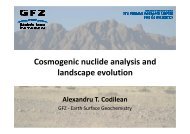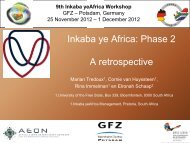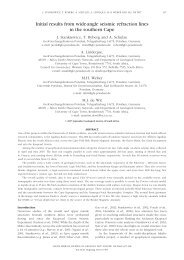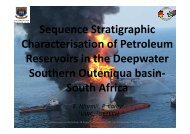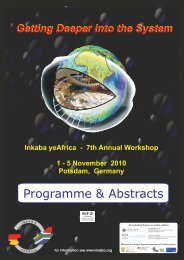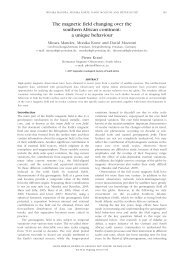South Africa - Inkaba.org
South Africa - Inkaba.org
South Africa - Inkaba.org
You also want an ePaper? Increase the reach of your titles
YUMPU automatically turns print PDFs into web optimized ePapers that Google loves.
Influence of long-term wheat residue management on soil<br />
fertility indicators of an Avalon soil at Bethlehem<br />
P.F. Loke 1 , E. Kotzé 2 , C.C. du Preez 3<br />
1. Department of Soil, Crop and Climate Sciences, University of the Free State, P.O. Box 339, Bloemfontein,<br />
Republic of <strong>South</strong> <strong>Africa</strong>, lokepf@yahoo.com<br />
2. Department of Soil, Crop and Climate Sciences, University of the Free State, P.O. Box 339, Bloemfontein,<br />
Republic of <strong>South</strong> <strong>Africa</strong>, kotzee@ufs.ac.za<br />
3. Department of Soil, Crop and Climate Sciences, University of the Free State, P.O. Box 339, Bloemfontein,<br />
Republic of <strong>South</strong> <strong>Africa</strong>, dpreezcc@ufs.ac.za<br />
ABSTRACT<br />
Awareness of the environmental aspects of soil quality and crop production has been increasing in recent years,<br />
which has led to renewed interest in crop residues as a source of soil <strong>org</strong>anic matter (SOM) and nutrients. Some<br />
residue management practices have been examined since 1979 in a long-term wheat trial at the ARC-Small Grain<br />
Institute near Bethlehem on an Avalon soil. This trial provides thus an excellent opportunity to evaluate the longterm<br />
effects of residue management on some soil fertility indicators and hence wheat response. The treatments that<br />
were applied are: straw disposal (burned and unburned), tillage (ploughing, stubble mulch and no-tillage) and weed<br />
control (chemical and mechanical). Soil samples were collected every 10 years at depth intervals of 0-50, 50-100,<br />
100-150, 150-250, 250-350 and 350-450 mm, and analysed for various soil fertility indicators. In 1999 tillage<br />
influenced SOM more than straw burning or weeding method, particularly in the upper 100 mm soil. No- and<br />
mulch tillage, especially when combined with chemical weeding increased SOM more than when ploughing was<br />
combined with mechanical weeding. Soil acidification was suppressed by burning and a combination of mulch or<br />
no-tillage with chemical weeding. P, K, Cu, Fe, Mn and Zn were higher in the burned plots than in unburned. This<br />
was also true for no- and mulch tillage in the upper 150 mm soil compared to ploughing. Grain yield did not<br />
correspond with the higher <strong>org</strong>anic matter and pH resulting from mulch and no-tillage. This could be attributed to<br />
low availability of nutrients in the upper 150 mm soil. The 30 year measurements confirm to a large extent the<br />
results of 1999.<br />
KEYWORDS: nutrients, <strong>org</strong>anic matter, soil acidity, straw disposal, tillage<br />
44



